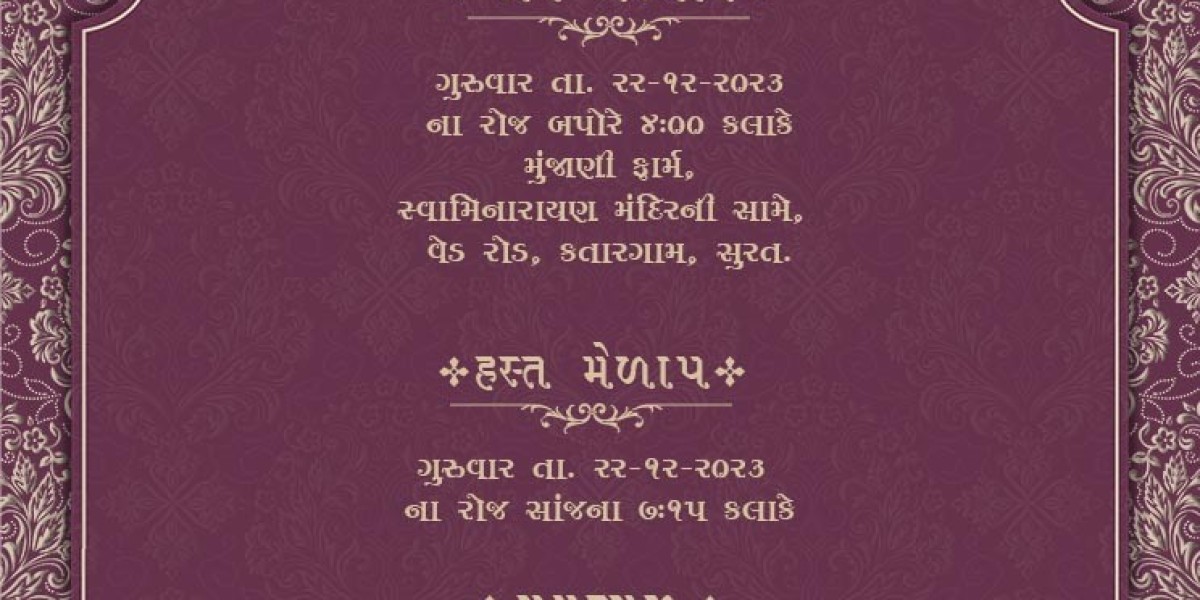At the heart of this celebration is the Kankotri—a traditional Invitation Card in Gujarati that not only serves as a formal invitation but also embodies the essence of Gujarati heritage. In this blog, we’ll delve into the significance of the Kankotri, explore its traditional elements, and provide insights on designing a contemporary Kankotri that respects tradition while embracing modern aesthetics.
What is a Kankotri?
A Kankotri is more than just an invitation; it is a cherished artifact that marks the beginning of a lifelong journey for a couple. Originating from the Gujarati community, this card is known for its intricate design and ornate details, which reflect the cultural and familial values of the bride and groom. Traditionally, the Kankotri is handed out to close family members and friends, serving as a symbol of respect and invitation to partake in the joyous occasion.
Traditional Elements of a Kankotri
Design and Motifs: The design of a Kankotri often features traditional motifs such as paisleys (mango designs), peacocks, lotus flowers, and intricate borders. These designs are imbued with cultural significance, symbolizing prosperity, purity, and beauty.
Color Palette: Vibrant and auspicious colors are a hallmark of Kankotri cards. Shades like red, gold, green, and maroon are commonly used, each representing different aspects of joy, wealth, and success. Gold accents are often incorporated to add a touch of luxury and elegance.
Gujarati Script: The text on a Kankotri is typically written in Gujarati script, which adds a personal and traditional touch. The language used is formal and respectful, conveying the importance of the occasion.
Religious Symbols: It’s common to see religious symbols such as Ganesh or Lakshmi in the design. These symbols are believed to bring blessings and ensure a prosperous future for the couple.
Family Crest: Many Kankotris feature the family crest or emblem, which is a symbol of the family’s heritage and pride. This personal touch makes each Kankotri unique and special.
Modernizing the Kankotri
While maintaining the traditional essence of a Kankotri is important, incorporating modern elements can make the card more appealing to contemporary audiences. Here are some ways to modernize the Kankotri while staying true to its cultural roots:
Minimalist Design: Modern designs often favor a minimalist approach. You can opt for clean lines and subtle patterns while retaining traditional elements. This creates a sophisticated look that appeals to a wider audience.
Digital Kankotri: With the rise of digital communication, many families are opting for digital Kankotris. These can be designed and sent via email or social media, combining traditional content with modern convenience. Digital versions can also include interactive elements such as RSVP links and event details.
Eco-Friendly Materials: In response to environmental concerns, eco-friendly materials are becoming popular. Consider using recycled paper or sustainable materials for a modern, eco-conscious touch.
Custom Illustrations: Custom illustrations that reflect the couple’s interests or story can add a personal and contemporary twist. For example, a hand-drawn depiction of the wedding venue or the couple can make the invitation unique.
Typography: Modern typography can be paired with traditional Gujarati script to create a blend of old and new. Experimenting with fonts and styles can enhance the overall aesthetic while keeping the message clear and elegant.
Creating a Kankotri: Step-by-Step Guide
Choose the Design Theme: Decide on a theme that reflects the couple’s personalities and preferences. Whether you choose a traditional, contemporary, or fusion theme, ensure that the design aligns with the overall wedding theme.
Select the Color Scheme: Pick colors that are both vibrant and meaningful. Traditional colors like gold, red, and green can be used, or you can opt for a modern palette that complements the wedding decor.
Draft the Content: Write the text in Gujarati, including essential details such as the wedding date, time, venue, and any special instructions. Ensure the language is formal and respectful, and double-check for accuracy.
Incorporate Design Elements: Add traditional motifs, religious symbols, and family crests. If you’re opting for a modern design, balance these elements with contemporary touches like minimalist patterns or custom illustrations.
Proofread and Finalize: Before finalizing the Kankotri, proofread the text and review the design to ensure there are no errors. It’s also helpful to get a second opinion to ensure that the card is both visually appealing and informative.
Printing and Distribution: Once the design is finalized, select a high-quality printing service to ensure the card looks professional. For digital Kankotris, test the final version to ensure all links and interactive elements work correctly.
Conclusion
The Kankotri is a beautiful representation of Gujarati tradition and culture, embodying the joy and significance of a wedding celebration. By blending traditional elements with modern design techniques, you can create a Kankotri that not only honors cultural heritage but also appeals to contemporary sensibilities. Whether you choose a classic design or a modern twist, the Kankotri will remain a cherished keepsake for all who receive it, marking the beginning of a new chapter in the couple’s life. Embrace the artistry and cultural richness of the Kankotri, and celebrate this special occasion with elegance and grace.








